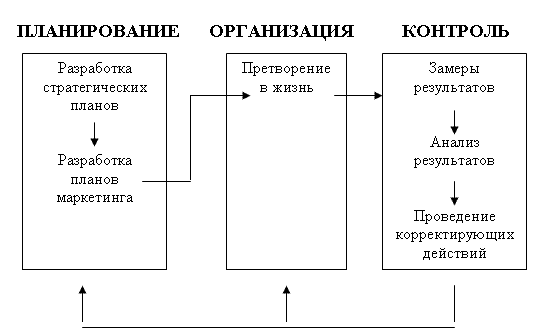home
 Marketing Marketing
 Basics of Marketing - Kotler Philip Basics of Marketing - Kotler Philip
|
Basics of Marketing - Kotler Philip
Chapter 17. Strategy, planning, control
Objectives
After reading this chapter, you should be able to:
1. Tell how the firm develops its policy statement and defines the objectives.
2. To name and characterize three variants of the company's growth strategy.
3. List and describe sections of the marketing plan.
4. Tell about three methods used by firms to monitor their marketing plans.
Strategic planning in loan business
"United" (the name is fictitious) is a large Chicago bank that provides services to a wide clientele and deals in commercial transactions. The latter are under the responsibility of its commercial department, consisting of specialized groups in the fields of activity, such as transport, communications and utilities, as well as groups for working with small producers
The transport group of the bank deals with airlines, road transport companies, railways, bus companies and water freight companies. For 20 years, the group was led by a loan specialist who was considered a successful manager. Every year, his group increased the amount of loans extended by the bank to transport enterprises by 5-15%. He worked without any plan, encouraging his subordinates to spend as much time as possible with the leaders of transport companies and not to miss a single opportunity when they opened. When subordinates sometimes did not work, he forced them to be more aggressive in working with the client.
When this head retired, the bank appointed a rather young specialist with a master's degree in business administration to replace him. His approach to work turned out to be quite different. He asked the bank's marketing research department to provide him with information on the total amount of loans issued to transport companies by all banks in the region, to provide information on marketing strategies and market shares held by competing banks and to estimate the main financial needs of transport companies for the future. One of the main discoveries after studying the collected materials was the conclusion that the bank used the market potential less than 50%. After this, the new loan specialist created a planning and control system that required the definition of objectives, the formulation of strategic approaches and the development of action programs for different segments of the transport market. He appointed managers for the market segments responsible for developing action plans and methods for monitoring their implementation within their segments. Thanks to the application of the marketing planning and control system, the new manager doubled the amount of loans granted to transport enterprises in two years.
It is quite clear that many firms need to improve the officially adopted planning and control systems. Constant acceptance of all kinds of decisions does not at all replace planning. For the company, planning is a higher-order activity, which often leads to improved sales and profits.
In this chapter, we will look at how individual elements of the marketing mix are combined into integrated plans, how these plans are implemented, and how their implementation is monitored. The relationship between planning and control is clearly illustrated in Fig. 83.

Fig. 83. The relationship between planning, marketing and control
Planning consists of two parts - strategic planning and marketing planning.
Control consists in measuring and analyzing the results achieved in the framework of strategic marketing plans, and in conducting appropriate corrective actions.
Implementation of the plans is managed by the marketing department (the structure of the marketing organization is described in Chapter 2).


Comments
When commenting on, remember that the content and tone of your message can hurt the feelings of real people, show respect and tolerance to your interlocutors even if you do not share their opinion, your behavior in the conditions of freedom of expression and anonymity provided by the Internet, changes Not only virtual, but also the real world. All comments are hidden from the index, spam is controlled.